Sun bears are some of the most stunning bears in the world and are easily recognizable with their unique horse-shoe-shaped marking on their chest. These small yet fascinating bears are native to the tropical forests of Southeast Asia. They are highly arboreal and spend much of their time living amongst the trees where they nest. But that’s not all as there is plenty more to learn about them – including finding out why they are some of the most important animals around. So join us as we discover 10 incredible sun bear facts!
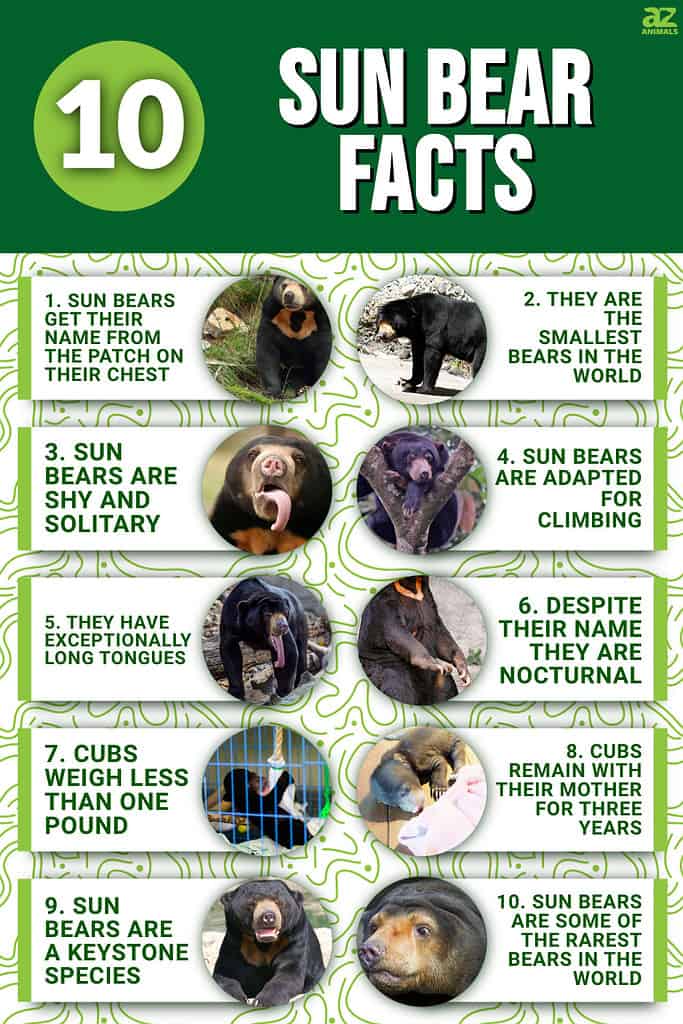
1. Sun Bears Get Their Name From the Patch on Their Chest
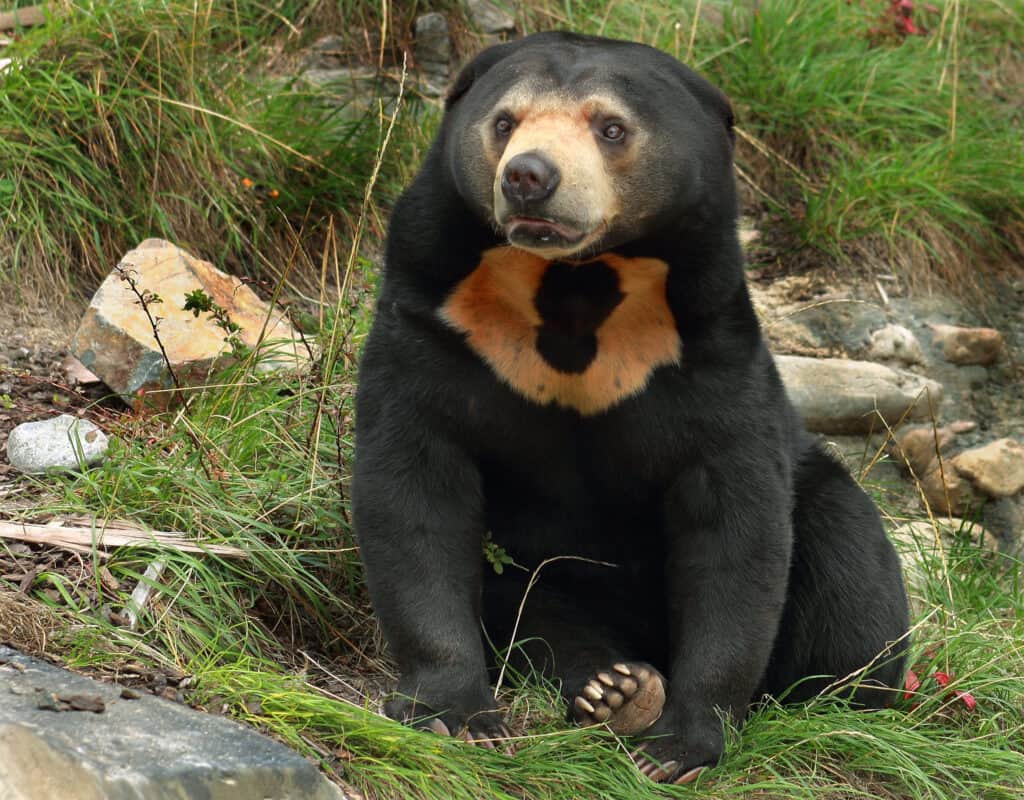
Sun bear chest patterns are mostly u-shaped.
©Molly NZ/Shutterstock.com
Sun bears have clearly got one of the loveliest and brightest sounding names in the animal kingdom. Yet you might be wondering just how a bear manages to have a name like that. The answer is actually really simple – they get it because of their large, bright chest patch. Mostly it is U-shaped, but sometimes it can be circular and it is typically orange, yellow, or white. The rest of their bodies and black and their fur is short and silky. Their short hair is particularly suited for living in sweltering tropical climates so they don’t overheat.
2. They are the Smallest Bears in the World

Sun bears are the smallest species of bear in the world.
©Cacophony / Creative Commons – Original
Standing 28 inches high at the shoulder and weighing between 55 and 150 pounds, sun bears are the smallest species of bear in the world. They have stocky bodies and large paws, yet are still much smaller than American black bears (which weigh up to 375 pounds) and giant pandas (which can weigh up to 350 pounds). In comparison, the largest species of bear – polar bears – can weigh up to 1,500 pounds.
3. Sun Bears are Shy and Solitary

A surprisingly little amount is known about sun bears compared to other bear species.
©Vladimir Wrangel/Shutterstock.com
Sun bears are extremely shy and solitary creatures, and considering that they live in thick tropical forests it’s really quite understandable. In fact, they are so shy that they have barely been studied at all and little is truly known about them. However, what we do know about them is that they tend to avoid people as much as possible and especially in the most heavily logged areas of their habitat. When they do come across people they are not particularly aggressive or dangerous unless they are actively threatened or surprised. They are even shy around other members of their own species too. Most sun bears live solitary lives with the exception of females with cubs.
4. Sun Bears are Adapted for Climbing
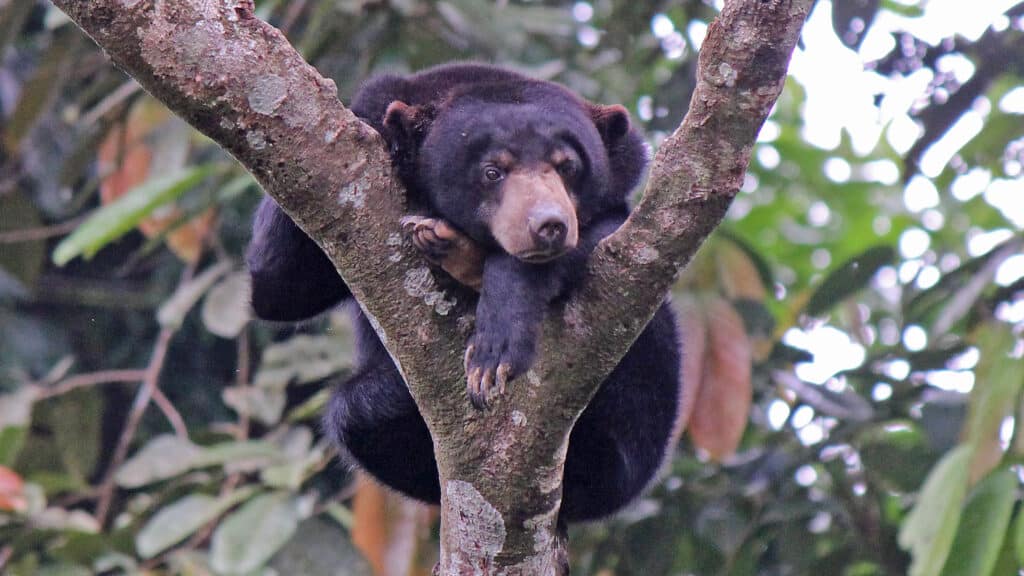
Sea bears are more comfortable in trees than other bear species.
©iStock.com/James Moore
As sun bears are the most arboreal out of all the bear species, it makes sense that they are uniquely adapted for climbing. Their main adaptation is their claws which are long, curved, and extremely sharp to help them grip tree trunks and branches. They also lack hair on the soles of their feet which is also thought to help them to grip better. Not only that, but their small size makes it much easier for them to climb, balance, and move between trees. It’s just as well that they are such capable climbers as they even sleep in nests in the trees! Their nests are usually made in the fork of a tree and are made from tree branches and twigs. The nests are pretty big too and can be up to 6 feet wide.
5. They have Exceptionally Long Tongues

Sun bear tongues can reach 10 inches long!
©iStock.com/xtrekx
Quite easily one of the most incredible sun bear facts is that they have really long tongues. That’s right, sun bears have tongues that can be up to an incredible 10 inches long! Their long tongue is actually really useful as they use it to extract honey and insects out of trees. Sun bears are even known as “honey bears” because they love honey so much. They are also known to break open termite mounds to lick out the contents – their long tongue allowing them to clean out every last tasty morsel. Sun bears are omnivores and eat a wide range of food – including termites, ants, beetles, larvae, fruits, berries, birds, and small mammals.
6. Despite their Name they are Nocturnal
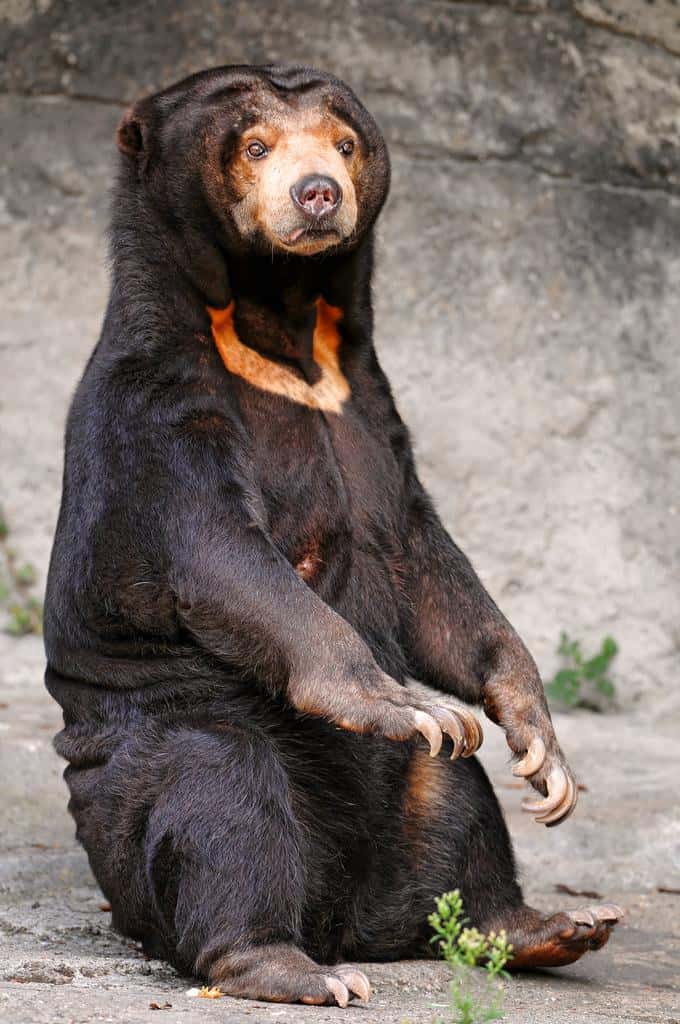
Sun bears are nocturnal and spend their nights foraging and their days sleeping
Considering their name, it would be easy to assume that sun bears are most active during the daytime, yet this is not the case. Instead, sun bears are actually nocturnal and spend their nights wandering around the forests in search of food. During the day they spend their time sleeping in their tree-top nests.
7. Cubs Weigh Less than One Pound
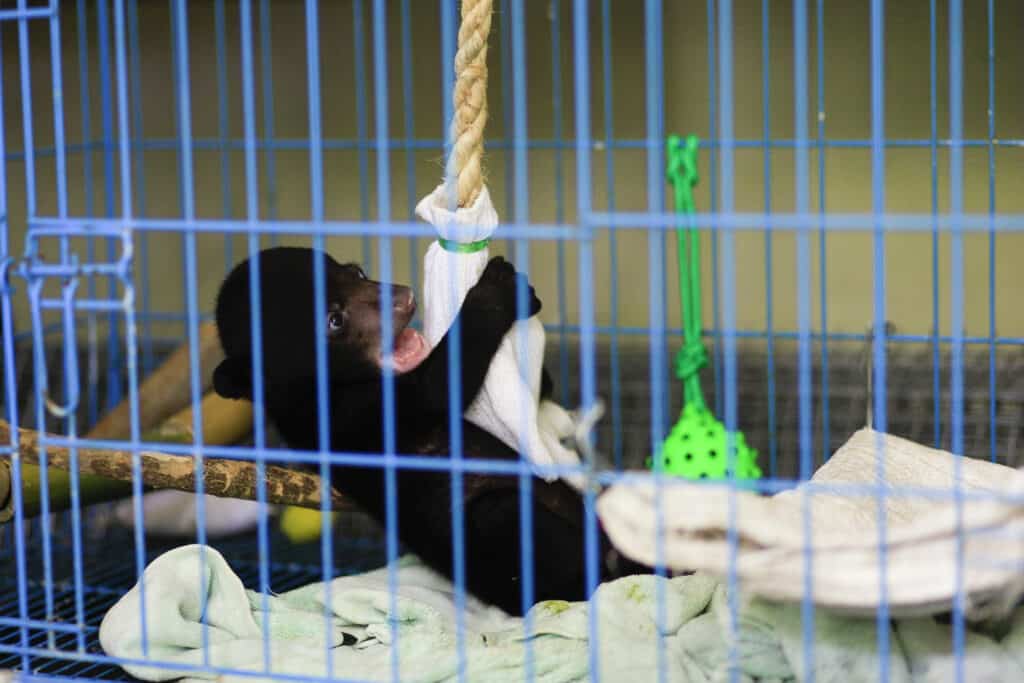
Sun bear cubs are incredibly small when first born.
©iStock.com/bari paramarta
Incredibly, sun bears are actually tiny when they are born – with cubs weighing only 11.5 ounces. Sun bears can give birth anytime throughout the year and typically have one or two cubs each time. The gestation period varies and can be anything between 95 and 240 days long. Cubs are born in nests in hollow trees, and are kept on buttress roots at the base of the trees until they begin to walk and climb at around 2 months old. Cubs are blind and deaf when they are born and are entirely reliant on their mother. Although their eyes open after 25 days, they remain blind until they are around 50 days old. This is approximately when their hearing is properly developed too.
8. Cubs Remain with Their Mother for Three Years
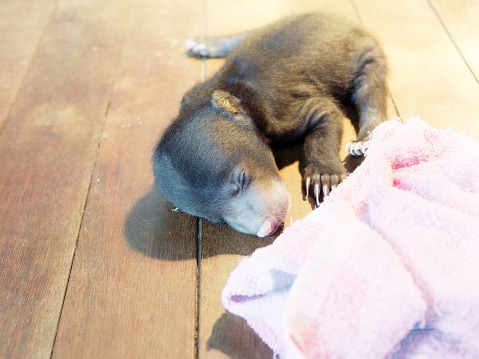
A baby sun bear in captivity. In the wild, sun bear cubs stay with their mothers for up to 3 years.
©yanjf/ via Getty Images
Following on from the point above, cubs typically remain with their mother until they reach maturity at around three years old. Surprisingly, the cubs are actually weaned from their mother’s milk by the time they are 4 months old. However, they still stay with her until they themselves are ready to breed. Largely, this is because even though they’re no longer reliant on her milk they still rely on her to teach them how to forage, climb, and build nests. Also, they still rely on her for protection from predators. Although they are not naturally aggressive animals, female sun bears fiercely defend their cubs from any potential threat. Predators of sun bears include tigers, snakes, and birds of prey.
9. Sun Bears are a Keystone Species
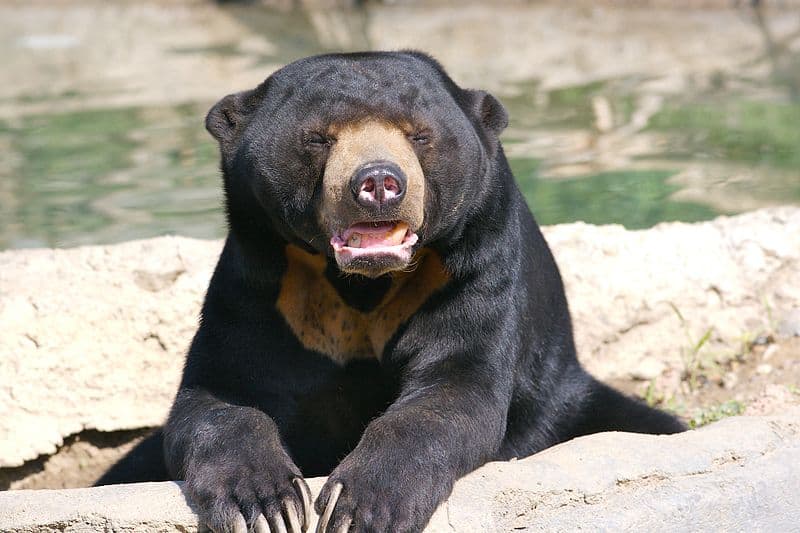
Sun Bears are a keystone species which means that many other animals benefit from the things that they do
Every animal has a role to play in maintaining the balance of the ecosystem and for some that role is bigger than others. Sun bears are one of the species which have a particularly big role as they are a keystone species which means that they are actually incredibly important to the entire ecosystem. This is because as a keystone species they are vitally important to the biodiversity of the habitat that they live in. Sun bears are important for seed dispersal as they spread seeds from the plants that they eat with their poop. They also help animals such as birds, insects, and small mammals by breaking open trees which creates new shelters and nesting areas for them.
10. Sun Bears are some of the Rarest Bears in the World
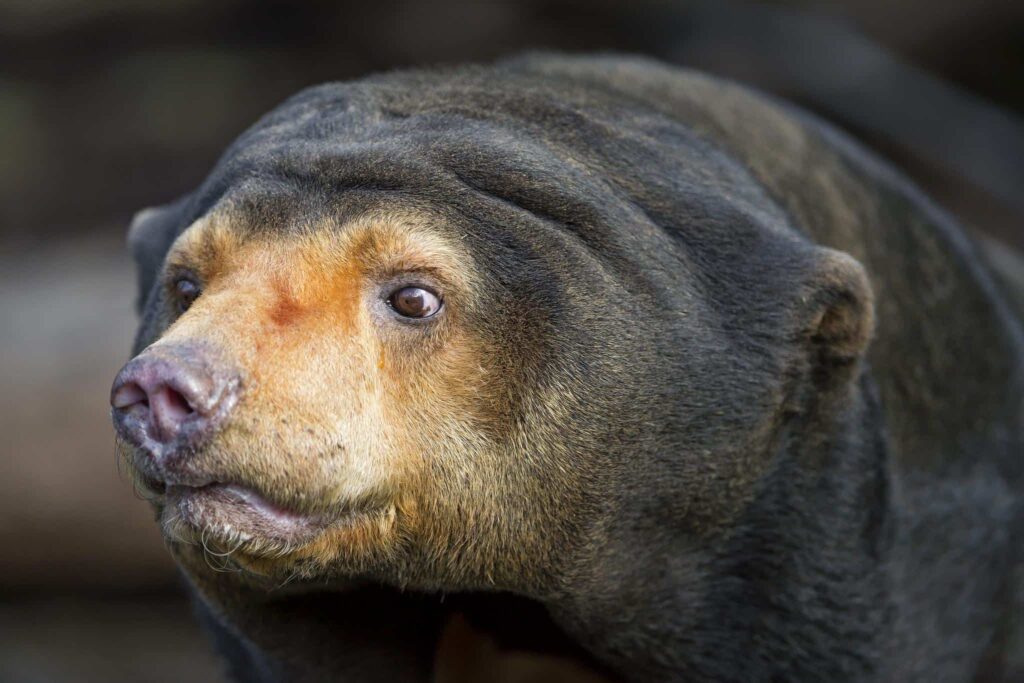
The sun bear is one of the rarest bear species on Earth.
©Tambako The Jaguar / Flickr – Original
Unfortunately, sun bears are under threat and they are officially classed as a vulnerable species. Sun bears are the second rarest species of bear in the world after giant pandas and their population is in decline. The biggest threats that they face today are habitat loss and hunting by poachers. Efforts are being made to try to provide additional protection for them and they are a protected species across their entire range. This is because as a keystone species have so many other animals which rely on them for their own survival. Therefore, any further decline in the sun bear population could well be disastrous for thousands more animals.
The photo featured at the top of this post is © iStock.com/xtrekx
Thank you for reading! Have some feedback for us? Contact the AZ Animals editorial team.







